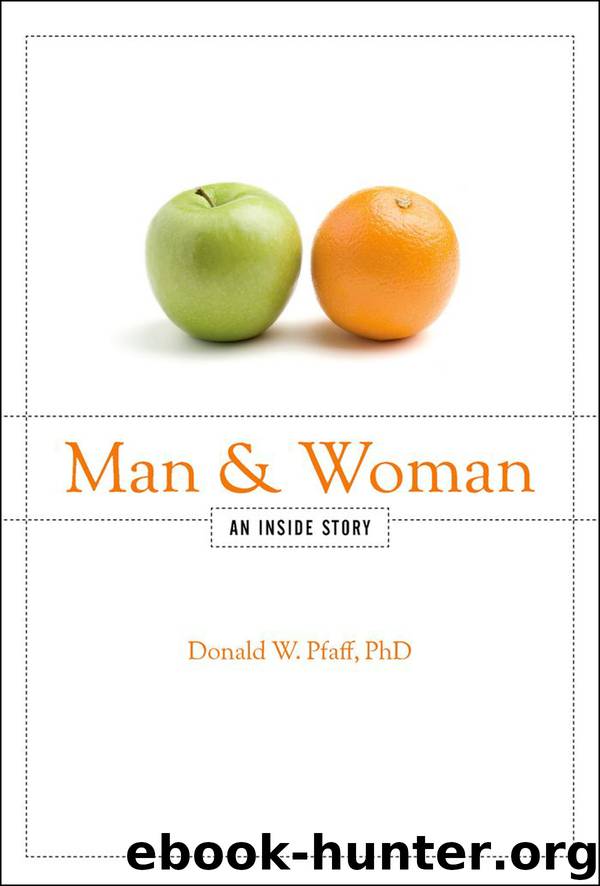Man and Woman by Pfaff Donald W

Author:Pfaff, Donald W.
Language: eng
Format: epub
Publisher: Oxford University Press, USA
Published: 2011-09-22T04:00:00+00:00
According to the results of Elena Choleris in our lab at Rockefeller University, estrogens (E) circulate in the blood and enter the brain. Arriving at the hypothalamic cell group, the paraventricular nucleus (PVN), they bind to estrogen receptor (ER)-beta and as a result stimulate transcription from the oxytocin (OT) gene. Some of those cells send axons to the amygdala. Meanwhile, estrogens have arrived at the amygdala and bind to ER-alpha, and thus can stimulate transcription from the OT receptor gene (OTR). When OT has bound to OTR, these amygdaloid neurons more efficiently process pheromonal and odor signals from other mice, producing better social recognition of other mice. Put these molecular mechanisms together, and you have a coherent theory of how estrogens foster friendly behaviors among laboratory animals that rely heavily on pheromonal and odiferous social signals. I propose that these mechanisms have been conserved even into the human brain, and are now combined with a variety of other regulatory mechanisms.
I note that Elena Choleris’ model of social recognition, even in these laboratory mice, does not invoke a simple-minded statement that claims “one gene/one behavior”—i.e., turn on gene A and behavior B pops out. Newspaper reporters sometimes talk that way, because classically in genetics, decades ago, George Beadle and Edward Tatum, studying the fungus Neurospora, won the Nobel prize for their “one gene/one enzyme” concept. But modern neuroscientists have moved beyond that. In my lab, to explain mechanisms for behaviors that are different between males and females, we have shown that patterns of genes govern patterns of behaviors.
Nor does Choleris try to wrap up the explanation of social recognition and altruism in a single gene. Her reluctance to do that is ratified by a mathematical approach reported in Nature in 2009 by mathematicians Vincent Jansen and Minus van Baalen, at the University of London. By simulating what would happen in social conflict, setting cooperative instincts against selfish instincts, and by assuming that social recognition and altruism are always inherited together, Jansen and van Baalen mathematically tested the implications of the simplest idea: that social recognition and altruism both depended exclusively on the same gene. Their calculations revealed that that coinheritance would lead to great instability. Social cooperation would bounce from absent to present, depending on whether or not that single gene existed in an individual, in a manner that would not be sufficient to support a normal society, animal or human. If, instead, they assumed that social recognition and altruism were caused by “loosely coupled separate genes,” then the potential would increase for the development of a variety of recognizable features across the population that would greatly foster altruistic behavior. Jansen and van Baalen’s conclusion is important because it provides a genetic mechanism by which people could recognize each other as altruistic and behave appropriately even if they are not in the same family or otherwise related to each other.
Biologists have long ago grasped how social behavior networks have evolved among all animals with backbones, vertebrates, encompassing a range of animals from fish through the types of laboratory mammals whose maternal behavior I described previously.
Download
This site does not store any files on its server. We only index and link to content provided by other sites. Please contact the content providers to delete copyright contents if any and email us, we'll remove relevant links or contents immediately.
| Administration & Medicine Economics | Allied Health Professions |
| Basic Sciences | Dentistry |
| History | Medical Informatics |
| Medicine | Nursing |
| Pharmacology | Psychology |
| Research | Veterinary Medicine |
Periodization Training for Sports by Tudor Bompa(8091)
Why We Sleep: Unlocking the Power of Sleep and Dreams by Matthew Walker(6543)
Paper Towns by Green John(5018)
The Immortal Life of Henrietta Lacks by Rebecca Skloot(4442)
The Sports Rules Book by Human Kinetics(4207)
Dynamic Alignment Through Imagery by Eric Franklin(4042)
ACSM's Complete Guide to Fitness & Health by ACSM(3931)
Kaplan MCAT Organic Chemistry Review: Created for MCAT 2015 (Kaplan Test Prep) by Kaplan(3902)
Introduction to Kinesiology by Shirl J. Hoffman(3694)
Livewired by David Eagleman(3616)
The River of Consciousness by Oliver Sacks(3490)
The Death of the Heart by Elizabeth Bowen(3477)
Alchemy and Alchemists by C. J. S. Thompson(3416)
Bad Pharma by Ben Goldacre(3201)
Descartes' Error by Antonio Damasio(3183)
The Emperor of All Maladies: A Biography of Cancer by Siddhartha Mukherjee(3013)
The Gene: An Intimate History by Siddhartha Mukherjee(3007)
The Fate of Rome: Climate, Disease, and the End of an Empire (The Princeton History of the Ancient World) by Kyle Harper(2970)
Kaplan MCAT Behavioral Sciences Review: Created for MCAT 2015 (Kaplan Test Prep) by Kaplan(2895)
